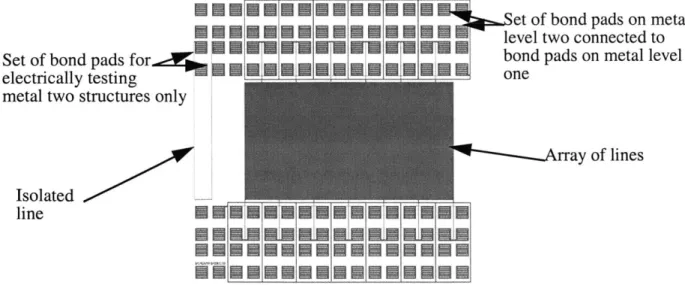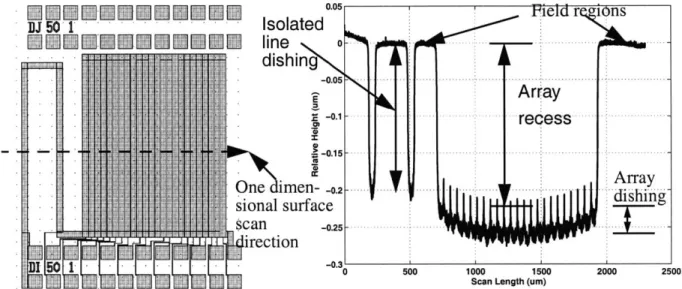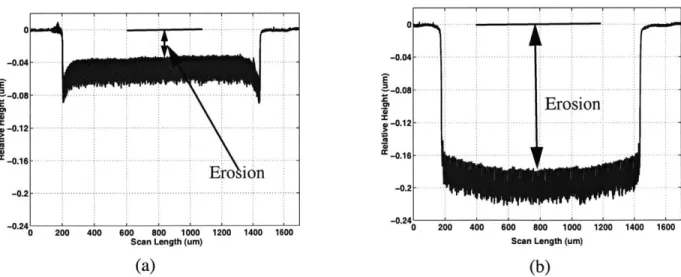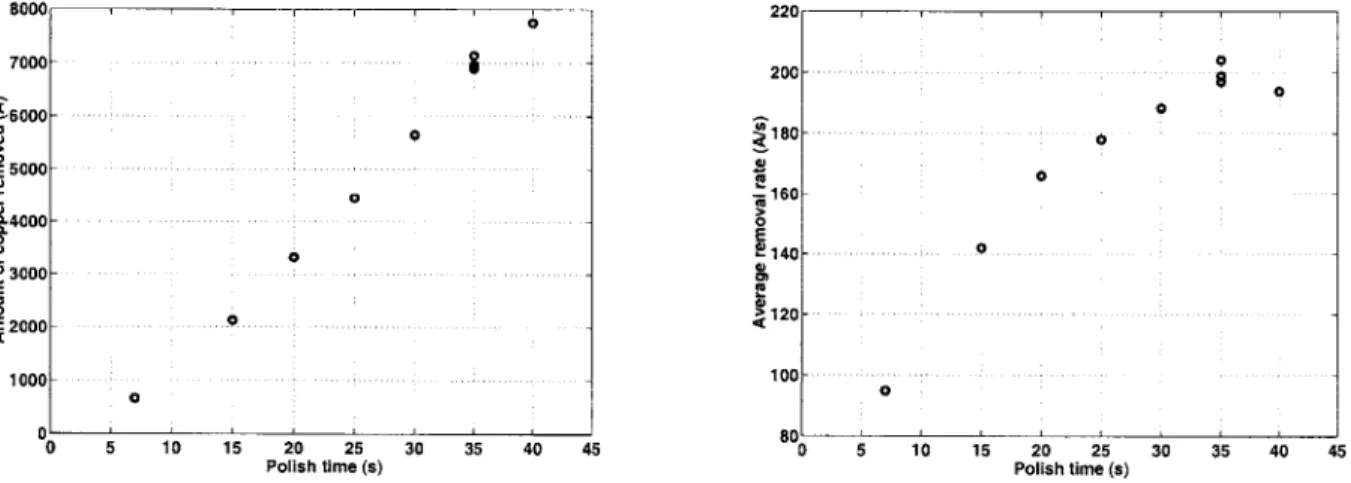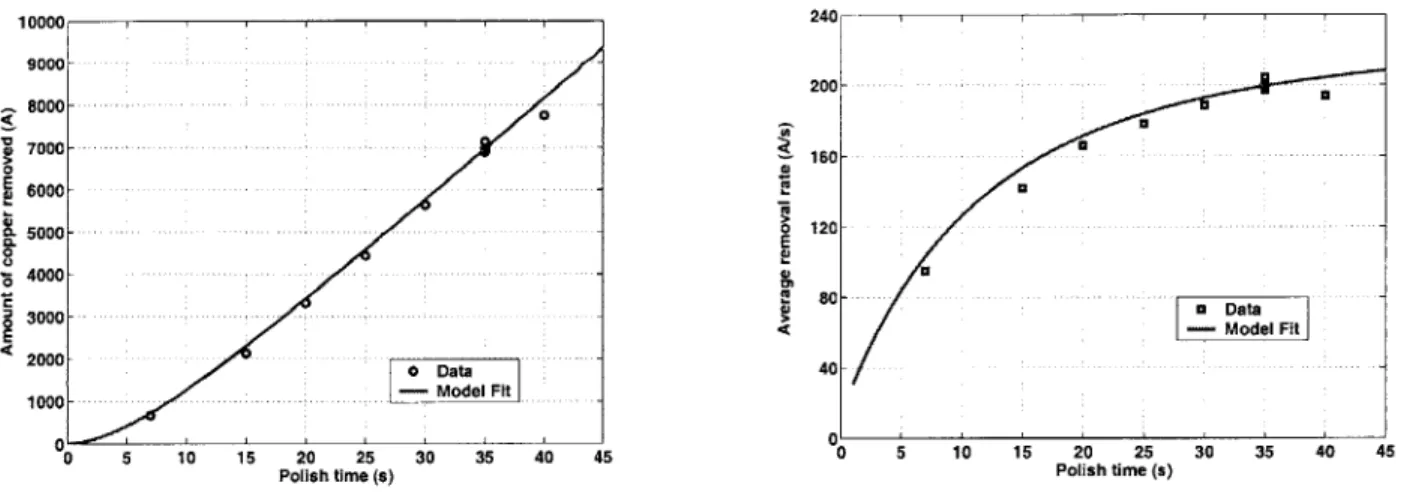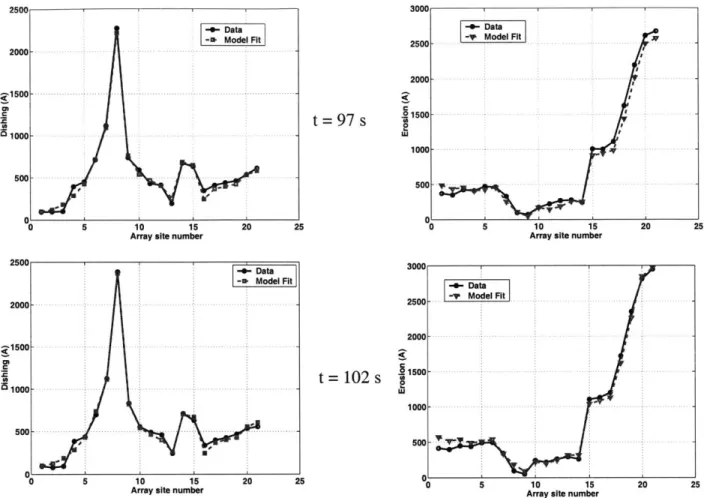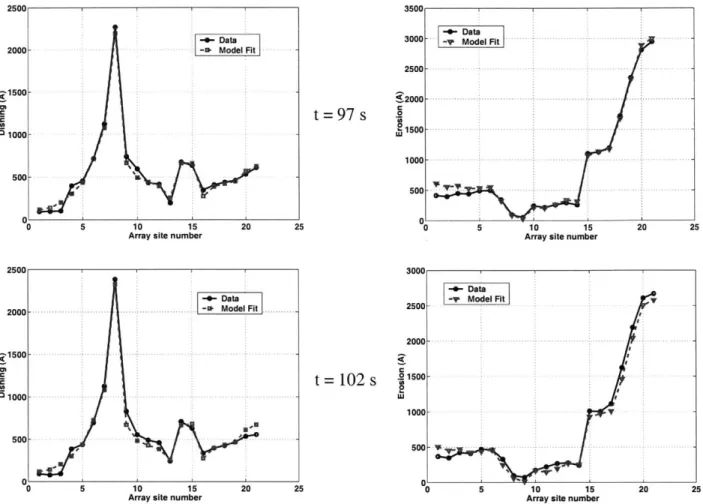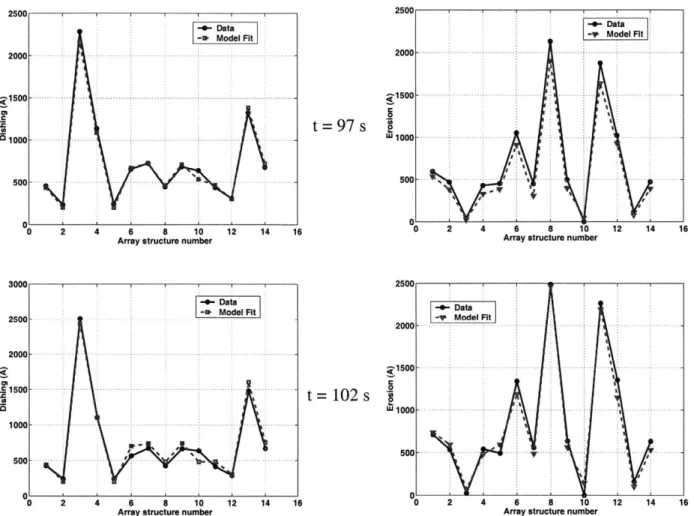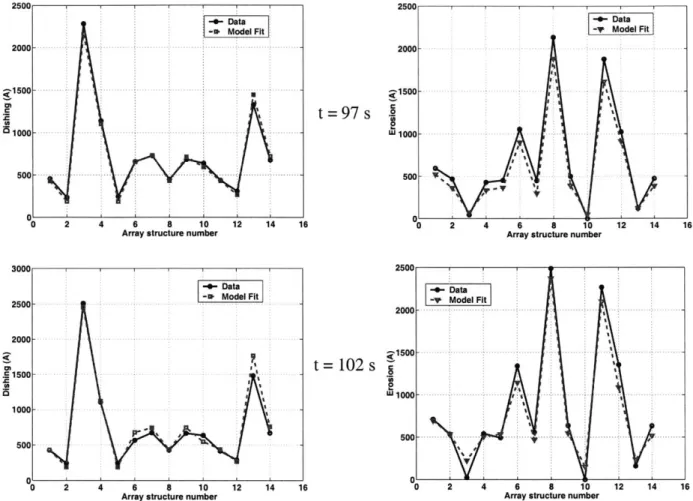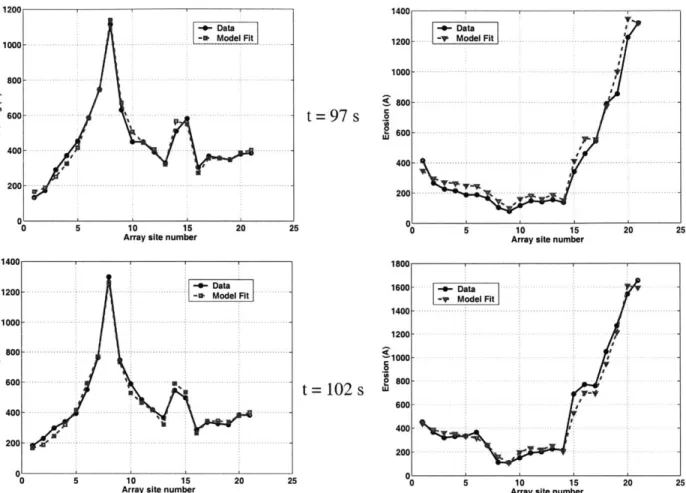-71
Chip-Scale Modeling of Pattern Dependencies in
Copper Chemical Mechanical Polishing Processes
by
Tamba E. Gbondo-Tugbawa
S.B., Electrical Engineering and Computer Science, MIT, June 1997 M.Eng., Electrical Engineering and Computer Science, MIT, February 1998
Submitted to the
Department of Electrical Engineering and Computer Science in partial fulfillment of the requirements for the degree of
Doctor of Philosophy at the
MASSACHUSETTS INSTITUTE OF TECHNOLOGY
May 2002
© Massachusetts Institute of Technology, 2002. All Rights Reserved.
A u th o r ...
Department of ElectricalVEngineering and Computer Science May 24, 2002
C ertified b y ... ...
Duane S. Boning Associate Professor of Electrical Engineering and Computer Science Thesis Supervisor
Accepted by ... .. ... - ... _ ! .... .
Arthur C. Smith Chairman, Department Committee on Graduate Students Department of Electrical Engineering and Computer Science
MASSACHUSETSMNTWUTE
OF TECHNOLOGY
Chip-Scale Modeling of Pattern Dependencies in
Copper Chemical Mechanical Polishing Processes
by
Tamba E. Gbondo-Tugbawa
Submitted to the Department of Electrical Engineering and Computer Science on May 24, 2002, in partial fulfillment of the requirements for the degree of
Doctor of Philosophy in Electrical Engineering and Computer Science
Abstract
Chemical mechanical polishing (CMP) has become a necessary processing step in the fabrication of copper interconnects. Copper CMP is recognized to suffer from pattern dependent problems such as dishing and erosion, which cause increased line resistance and non-uniformity within the die. The non-uniformity on one metal level can lead to cumulative non-uniformity on higher metal levels, leading to potential integration and manufacturing problems. Predictive pattern dependent models of copper CMP processes are therefore highly desirable for predicting dishing and erosion on random layouts, assessing the effectiveness of dummy fills in minimizing within-die non-uniformity, aiding in the generation of smart interconnect design rules, and identifying potential bulk copper clearing problems in multi-level metallization designs.
In this thesis, the first predictive semi-physical chip-scale pattern dependent model for copper CMP processes is developed. A comprehensive model calibration methodology for any multi-step copper CMP process is also developed. The model takes into account the initial long range electroplated topography, the effective pattern density, and the initial local step heights within the arrays. The model also accounts for the temporal evolution of the bulk copper thickness during CMP, the temporal evolution of dishing and erosion, and the layout dependencies of dishing and erosion. A three step conventional copper CMP process experiment and a single step abrasive-free copper CMP process experiment are performed to test the accuracy of the model and the calibration methodology. The results show that the model predicts the trends in the experimental data accurately, and fits the data to within acceptable errors.
The model and the calibration methodology are integrated with an empirical pattern dependent electroplating model and calibration methodology, to form a chip-scale copper electroplating and CMP simulator. Once the models that form the simulator are calibrated for a given copper CMP process, and a given copper electroplating process, the simulator can be used to: (1) predict dishing and erosion across an entire chip, for a random layout; (2) assess the effectiveness of dummy fills in minimizing within-die non-uniformity; (3) identify bulk copper clearing problems in multi-level metallization designs; and (4) aid in the generation of smart interconnect design rules. Preliminary experimental results show that the simulator predicts dishing and erosion across an entire chip reasonably well, for a random layout.
Thesis Supervisor: Duane S. Boning
Acknowledgments
First, I must thank God for making it possible for me to reach this level of academic achievement. Second, I would like to thank my thesis supervisor, Professor Duane Boning, for all the support and affirmation of confidence that I could ever ask for. I am truly grateful for his patience and guidance over the duration of this research. I would also like to thank the thesis readers, Professor Tayo Akinwande and Nannaji Saka for serving on my thesis committee.
This thesis is the result of significant industrial collaboration. I would like to thank Chidi Chidambaram, Christopher Borst, Greg Shinn, and Dennis Buss, of Texas Instruments Inc.; Lawrence Camilletti and Maureen Brongo of Conexant Systems Inc.; Paul Lefevre, Steven Hymes, Albert Gonzales, and Shinkook Lee, formerly of International SEMATECH; John Nguyen of SpeedFam-IPEC; Taber Smith, David White and Aaron Gower-Hall of Praesagus Inc.; and Sookap Hahn of SKW Associates.
This thesis would not have been completed without the support of my colleagues at MIT. Specifically, I would like to thank the following people, including both current students and staff, and recent graduates: Tae Park, Brian Lee, Xiaolin Xie, Karen Gonzales-Valentin, Joseph Panganiban, Nigel Drego, Vikas Mehrotra, Han Chen, Mike Mills, James Fiorenza, Matthew Varghese, John Fiorenza, Andy Fan, Arifur Rahman, Hasan Nayfeh, Peter Orondo, Hector Briceno, Solomon Assefa, Oluwamuyiwa Olubuyide, Dennis Ouma, Amrit Pant, Wasi Wahid, Raja Jindal, Akin Aina, Deborah Hodges-Pabon, and Sharlene Blake.
Finally, I would like to thank my family for their love and encouragement throughout my academic career at MIT. For their support and sacrifice, I dedidate this thesis to them.
This work has been supported in part by DARPA, PDF Solutions Inc., Texas Instruments Inc., and the SRC/NSF ERC for Environmentally Benign Semiconductor Manufacturing.
Table of Contents
Chapter 1
Chapter 2
Chapter 3
Introduction ... 19
1.1 Chemical Mechanical Polishing (CMP) Processes... 21
1.2 Copper CMP Processes and Issues ... 23
1.3 T hesis G oals... . 29
1.4 Thesis Organization ... 30
Framework for Modeling Pattern Dependencies in Copper CMP
Processes ...
33
2.1 Literature Review of Copper CMP Modeling ... 34
2.2 Modeling and Characterization Framework ... 40
2 .3 T est M asks ... . 42
2.3.1 MIT Cu Mask Version 1.2... 42
2.3.2 GA303 Mask...43
2.3.3 MIT-SEMATECH 854 Mask ... 46
2.3.4 SEMATECH-MIT 862 Mask ... 47
2.4 M etrology ... . . 48
2.4.1 Copper Thickness Measurements ... 49
2.4.2 Surface Profile Measurements ... 50
2.4.3 Dielectric Thickness Measurements ... 53
2.5 Characterization and Prediction Methodology ... 53
The Density-Step-Height Model for Single Step Copper CMP
Processes...
55
3.1 Model Formulation for Intrinsic Stage One: Bulk Copper Clearing S tag e ... . 5 6 3.1.1 Evolution of Step Height ... 60
3.1.2 Evolution of Bulk Copper Thickness... 61
3.2 Model Formulation in Intrinsic Stage Two: Barrier Clearing Stage... 64
3.3 Model Formulation in Intrinsic Stage Three: Overpolish Stage... 68
3.4 Model Parameters ... 71
3.4.1 Model Parameters in Intrinsic Stage One ... 71
3.4.2 Model Parameters in Intrinsic Stages Two and Three ... 75
3.4.3 Summary of Model Parameters ... 79
3.5 E dge R ounding... 79
3.6 Time Dependency of Blanket Removal Rate... 86
3.7 Model Calibration Methodology for Single Step Processes ... 93
3.7.1 Calibration Experiments and Measurements ... 94
3.7.2 Extraction of Model Parameters ... 97
3.7.3 Checking the Accuracy of the Model Parameter Extraction
Chapter 4
Chapter 5
Chapter 6
3.8 Model Fits versus Experimental Data... 103
3.8.1 Model Parameter Extraction in Intrinsic Stage Three, for E xperim ental Set # 1...106
3.8.2 Model Parameter Extraction in Intrinsic Stage Three for E xperim ental Set # 2 ... 108
3.9 Limitations of the Density-step-height Model... 111
3.9.1 The "Ear" or "Array-edge" Effect ... 112
3.9.2 Excessive O verpolishing...116
3 .10 S um m ary ... 1 18
Application of the Density-Step-Height Model to Non-Prestonian
Copper CM P Processes ...
119
4.1 An Overview of Abrasive-Free Copper CMP Processes... 119
4.2 Model Formulation for Single Step Abrasive-Free Copper CMP P ro ce sses ... 12 1 4.2.1 Model Formulation in Intrinsic Stage one: Bulk copper p o lish in g ... 12 2 4.2.2 Model Formulation in Intrinsic Stage Three: Overpolish S tag e ... 12 5 4.2.3 Model Parameters and Model Calibration Methodology...127
4.3 Model Fit versus Experimental Data ... 128
4.3.1 Experimental Data and Model Parameter Extraction ... 130
4 .4 S um m ary ... 139
Application of the Density-Step-Height Model to Multi-Step
Copper CM P Processes...141
5.1 Formulation of Model for Multi-Step Processes ... 142
5.2 Calibration Methodology for Multi-Step Copper CMP Processes ... 154
5.2.1 Calibration Experiments and Metrology...154
5.2.2 Model Parameter Extraction Methodology...156
5.2.3 Checking the Accuracy of the Extraction Results ... 158
5.3 Model Fits versus Experimental Data for Multi-Step Copper CMP P ro ce sses ... 15 9 5.3.1 Extraction of Model Parameters for Step One Polish P ro ce ss ... 16 2 5.3.2 Extraction of Model Parameters for Polish Step Two P ro ce ss ... 16 8 5.3.3 Extraction of Model Parameters for Step Three Process...174
5.3.4 Checking the Accuracy of the Extraction ... 179
5 .4 S u m m ary ... 182
Integrated Contact Mechanics and Density-Step-Height
M odel...185
6.1 Framework of Contact Wear CMP Models ... 186
Chapter 7
Chapter 8
6.2.1 Calculation of Envelope Pressure P,... ... 190
6.3 Formulation of Integrated Model in Intrinsic Stage Three: O verpolish Stage ... 195
6.4 Model Parameters and Calibration Methodology ... 196
6.4.1 Model Calibration Methodology...197
6.5 Model Fits versus Experimental Data... 199
6.5.1 Extraction of Model Parameters for Step One Process...200
6.5.2 Extraction of Model Parameters for Step Two Process...204
6.5.3 Extraction of Model Parameters in Step Three...206
6.5.4 Checking the Accuracy of the Extraction ... 209
6 .6 S u m m ary ... 2 11
Chip-Scale
to ...
213
7.1 Framework for Chip-Scale Simulation ... 213
7.2 Layout Extractor ... ... 215
7.3 Electroplating Model... 216
7.4 Copper CMP Model... ... 216
7.5 Test Mask...217
7.6 Testing the Predictive Accuracy of the Chip-Scale Simulator ... 218
7 .7 S um m ary ... 225
Conclusion and Future Work
...
227
8.1...227
8 .1 S um m ary ... 227
8.2 F uture W ork ... 228
List of Figures
Figure 1.1: Figure 1.2: Figure 1.3: Figure 1.4: Figure 1.5: Figure 1.6: Figure 1.7: Figure 2.1: Figure 2.2: Figure 2.3: Figure 2.4: Figure 2.5: Figure 2.6: Figure 2.7: Figure 2.8: Figure 2.9: Figure 2.10: Figure 2.11: Figure 2.12: Figure 2.13: Figure 2.14: Figure 3.1: Figure 3.2: Figure 3.3: Figure 3.4: Figure 3.5: Figure 3.6: Figure 3.7: Figure 3.8: Figure 3.9: Figure 3.10: Figure 3.11: Figure 3.12: Figure 3.13: Figure 3.14: Figure 3.15: Figure Figure Figure 3.16: 3.17: 3.18:Delay versus feature size (from [1]) ... 20
Single damascene process flow ... 21
A sam ple rotary CM P tool... 22
A simplified version of the Lam Teres (from [2])...23
Definition of dishing and erosion ... 24
D efinition of recess ... 24
Cumulative non-uniformity effect ... 26
Copper CMP input and output variables... 33
Three intrinsic stages in copper CMP processes...41
MIT copper mask version 1.2: (a) Layout (b) Floor plan ... 43
Metal level one of GA303: (a) Layout (b) Floor plan ... 44
Metal level two of GA303: (a) Layout (b) Floor plan ... 44
Sample array on metal level one of GA303 mask ... 45
Sample array on metal level two of GA303 mask ... 46
MIT-SEMATECH 854 mask...47
SEMATECH-MIT 862 mask...48
Wafer layout scheme for 862 mask ... 48
Profilometer scan of large feature array after the bulk copper ... 51
Profilometer scan of electroplated fine-feature array ... 51
Profilometry scan of electroplated large feature array...52
Framework of characterization and prediction methodology ... 54
Step height evolution during bulk copper polishing ... 57
Pressure versus step height relationship ... 58
Relationship between removal rate and pressure...59
Removal rate diagram for bulk copper polish stage ... 59
Pre-CMP electroplated topography of an array ... 61
Sample topography at the beginning and the end of the barrier clearing stage ... 64
Pressure versus copper pre-dishing...65
Removal rate diagram for intrinsic stage two ... 66
Pressure versus copper dishing ... 69
Removal rate diagram for intrinsic stage three ... 70
Step height reduction with polish time: ... 73
Measured dishing versus line width for isolated lines ... 77
Profilometer scans of two regular arrays, showing the density effect on erosion: (a) Line width = 1 ptm; line space = 1 ptm; (b) Line width = 9 gm; line space = 1 m ... . . 80
E rosion versus polish tim e ... 81
Line space effect on dielectric erosion: (a) polish time = 98 s (bulk copper cleared; just entered overpolish stage); (b) polish time = 114 s (in overpolish sta g e ) ... 8 2 Dielectric erosion versus line space... 82
Local pressure on a line space (up-area)... 83
Figure Figure Figure Figure Figure Figure Figure Figure Figure Figure Figure Figure Figure 3.19: 3.20: 3.21: 3.22: 3.23: 3.24: 3.25: 3.26: 3.27: 3.28: 3.29: 3.30: 3.31: Figure 3.32: Figure 3.33: Figure 3.34: Figure 3.35: Figure 3.36: Figure 3.37: Figure 3.38: Figure 3.39: Figure 3.40: Figure 3.41: Figure 4.1: Figure 4.2: Figure Figure Figure Figure Figure Figure Figure 4.3: 4.4: 4.5: 4.6: 4.7: 4.8: 4.9:
Amount of copper removed and average removal rate for experiment # 1 ... 87
Amount of copper removed and average removal rate for experiment # 2...88
Amount of copper removed and average removal rate for experiment # 3 ... 88
Amount of copper removed and average removal rate for experiment # 4 ... 89
Non-linear removal rate model fit versus data for experiment # 1 ... 91
Non-linear removal rate model fit versus data for experiment # 2...91
Non-linear removal rate model fit versus data for experiment # 3 ... 91
Non-linear removal rate model fit versus data for experiment # 4...92
Temperature and instantaneous removal rate versus polish time ... 92
Model parameter extraction procedure for intrinsic stage one ... 98
Model parameter extraction procedure for intrinsic stage three ... 100
Array sites used in the extraction of model parameters for stage three ... 107
Model fit versus data for experiment set # 1, for extraction without edge ro un din g ... 10 8 Model fit versus data for experimental set # 1, for extraction with edge ro u n d in g ... 10 9 Array structures used in testing the accuracy of the extraction in stage three...109
Model prediction versus data in experimental set # 1, to test the accuracy of the extraction (with the edge rounding effect included) procedure in intrinsic stage three ... 1 1 0 Model prediction vs. data in experimental set # 1, to test the accuracy of the extraction (with the edge rounding effect neglected) procedure in stage three .. 111
Model fits versus data (experimental set # 2) for extraction without edge rounding, in stage three...112
Model fits versus data (experimental set 2) for extraction with edge rounding, in intrinsic stage three ... 113
Profilometer scan of array with line width of 0.18 jim and line space of 0.18 pm, show ing the ear effect ... 114
Profilometer scan of high density array structure showing no ear effect ... 114
Profilometer scans showing dishing of sub-micron isolated lines...115
Plot of erosion versus polish time showing model failure when excessive overpolishing is done ... 117
Removal rate versus down force for different abrasive-free slurry solutions (fro m [16 ]) ... 12 0 Removal rate vs. pressure curves for 430-1 Hitachi slurry on different CMP tools (fro m [4 3 ]) ... 12 1 Approximate removal rate versus pressure relationship ... 122
Pressure versus step height relationship ... 123
Removal rate diagram for intrinsic stage of abrasive-free copper CMP process 124 Removal rate diagram for intrinsic stage one of abrasive-free CMP process...124
Pressure versus dishing relationship in intrinsic stage three...125
Removal rate diagram for intrinsic stage three of abrasive-free process...125 Profilometer scans for two arrays with same density, but different line widths:
(a) Line width = 1 ptm; Line space = 1 pm (b) Line width = 10 jim; Line space = 10 p m ... 1 3 1
Figure 4.11: Figure 4.12: Figure 4.13: Figure 4.14: Figure 4.15: Figure 4.16: Figure 4.17: Figure 5.1: Figure 5.2: Figure 5.3: Figure 5.4: Figure 5.5: Figure 5.6: Figure 5.7: Figure Figure Figure 5.8: 5.9: 5.10: Figure 5.11: Figure 5.12: Figure 5.13: Figure 5.14: Figure 5.15: Figure 5.16: Figure 5.17: ... ... 1 3 1
Profilometer scans of two arrays with same line width, but different densities:
(a) Line width = 50 [tm; Density = 50% (b) Line width = 50 gim; Density = 99%...
... 1 3 2
Measured dishing versus layout copper pattern density for AFP ... 133
Measured erosion versus layout copper pattern density for AFP ... 133
Array sites used in the extraction of model parameters ... 136
D ishing and erosion versus polish tim e ... 137
Dishing and erosion versus line widths and pattern density: (a) Density = 50%; Polish time = 172 s (b) Line space = 1 pim; P olish tim e = 172 s...137
Model fits vs. experimental data (for AFP) for different array sites on test m a sk ... 13 8 Relevant intrinsic stages for the steps of a three step copper CMP process...143
Formulation of removal rate diagram for intrinsic stage one (bulk copper polish) of step one in a three step copper CMP process ... 144
Formulation of removal rate diagram for intrinsic stage two (barrier removal) of step two in a three step copper CMP process ... 144
Formulation of the removal rate diagram for intrinsic stage three (overpolish) of step two in a three step copper CMP process ... 145
Formulation of the removal rate diagram for intrinsic stage two (barrier clearing) of step three in a three step copper CMP process...145
Formulation of the removal rate diagram in intrinsic stage three (overpolish) of step three in a three step copper CMP process ... 146
Model parameter extraction methodology for step three of a three step p ro ce ss...15 8 Amount of copper removed on blanket wafers versus polish time...163
Model fit versus data for blanket copper removal rate, as per equation 3.50 ... 163
Extracted effective blanket copper removal rate for step one process versus tim e ... 16 3 Step height versus polish time for 100 mm line width, 100 mm line space structure array structure, in step one...164
Model fits versus experimental data for model parameter extraction in step one: (a) A rray up-area site (b) Field sites ... 165
Array and field site numbers of sites used in extraction of model parameters, for three-step copper CMP process (the mask is MIT mask version 1.2): (a) A rray up-area sites (b) Field sites...166
Measured initial electroplated copper thickness: (a) Array up-area sites (b ) F ield sites...16 7 Amount of copper removed and measured blanket removal rate vs. time, for step tw o process ... 168
Amount of oxide removed and measured blanket oxide removal rate vs. time, for step tw o process ... 169
Amount of barrier removed and measured blanket barrier removal rate vs. time, for step tw o process ... 169
Figure 5.18: Figure 5.19: Figure 5.20: Figure 5.21: Figure 5.22: Figure 5.23: Figure 5.24: Figure 5.25: Figure 5.26: Figure 5.27: Figure Figure Figure Figure Figure Figure Figure Figure 5.28: 6.1: 6.2: 6.3: 6.4: 6.5: 6.6: 6.7: Figure 6.8: Figure Figure 6.9: 6.10: Figure 6.11: Figure 6.12: Figure 6.13: Figure 6.14:
Measured dishing versus polish time in step two and line width, for arrays with line width equal to line space: (a) t represents polish time (b) w represents
lin e w id th ... 17 0 Measured erosion versus polish time and density for several array structures: (a) w and s represent line width and line space respectively (b) t represents
p o lish tim e ... 17 0
Model fits versus experimental data for model parameter extraction in step
two, with no edge rounding effect included in the model equations ... 172
Model fits versus experimental data for extraction in step two, with the edge rounding effect included in the model equations...173
Profilometer scan of an array showing severe edge rounding in step three...175
Evolution of dishing and recess during step three polish for a 100 mm line width and 100 pm line space array structure, with an isolated line...176
Measured dishing versus line width and polish time for several arrays: (a) t represents polish time (b) width represents line width...177
Measured erosion versus polish time in step three, for several arrays. The variable w represents line width and the variable s represents line space. An esti-mate of the layout copper pattern density is the line width divided by the sum of the line w idth and space...177
Model fit versus experimental data, in the case where the edge rounding effect is n eg lected ... 180
Model fits versus experimental data, in the case where the edge rounding effect is included in the m odel equations ... 181
Complete simulation of three step process compared to experimental data...183
Bottom-up fill electroplated profile for several arrays of lines...188
Envelop function for the electroplated profile shown in figure 6.1...188
Iterative implementation of integrated model for intrinsic stage one ... 189
Wafer-pad set up for envelope pressure computation...192
Iterative methodology for computing the envelop pressures...194
Iterative implementation of integrated model in intrinsic stage three ... 195
Integrated model parameter extraction procedure in intrinsic stage one of single step copper C M P process...200
Integrated model parameter extraction procedure in intrinsic stage three of a single step copper CM P process ... 201
Simulated electroplated copper thicknesses across die...202
Simulated versus measured electroplated copper thickness: (a) A rray (b) F ield ... 202
Array and field sites used in extraction of model parameters...203
Initial envelope function and the corresponding initial envelope pressure (the die is discretized into cells, each of size 240 grm by 240 pm)...203
Model fits versus experimental data for model parameter extraction in step one -ICDSH: Integrated contact mechanics and density-step-height model D SH : D ensity-step-height m odel... 205
Model fits versus experimental data, for model parameter extraction in step
Figure 6.15: Figure 6.16: Figure Figure Figure Figure Figure Figure Figure Figure Figure 7.1: 7.2: 7.3: 7.4: 7.5: 7.6: 7.7: 7.8: 7.9: Figure 7.10: Figure 7.11: Figure 7.12: Figure 7.13:
Model fits versus experimental data for model parameter extraction in step
th re e ... 2 0 8
Complete simulation of three step process compared to experimental data
-ICDSH: Integrated contact mechanics and density-step-height model
D SH : D ensity-step-height m odel...210
Framework for chip-level copper interconnect simulation...214
Average line widths extracted by layout extractor ... 219
Local discretized layout density computed by layout extractor...220
Simulated electroplated copper thickness across chip ... 220
Simulated electroplated step heights across entire chip...221
Simulated local electroplated copper pattern density ... 221
Simulated dishing across die, after steps two and three polish of wafer Z-1...222
Simulated erosion across chip, after step two and three polish of wafer Z-1...222
Simulated dishing and erosion across entire die, after step two polish of w afer Z -2 ... 2 2 3 Simulated bulk copper clearing time across entire die, during step two polishing, of w afers Z-1 and Z-2 ... 223
Simulated dishing versus measured dishing at selected sites on die, after steps tw o and three polish, of wafer Z-1...224
Simulated erosion versus measured erosion at selected sites on die, after steps tw o and three polish, of wafer Z-1...224
Simulated dishing and erosion versus measured dishing and erosion at selected sites on die, after step two polish, of wafer Z-2...225
List of Tables
Table 3.1: Modeling parameters for single step copper CMP processes ... 79
Table 3.2: Time dependency of blanket rate experiments ... 87
Table 3.3: Extracted blanket rate equation variables ... 90
T able 3.4: Experim ental description ... 104
Table 3.5: Blanket wafer experiments in experimental set # 1...104
Table 3.6: Patterned copper wafer experiments in experimental set # 1 ... 105
Table 3.7: Blanket wafer experiments in experimental set # 2...105
Table 3.8: Patterned copper wafer experiments in experimental set # 2 ... 105
Table 3.9: Extracted model parameters in intrinsic stage three, for experimental se t # 1 ... 10 7 Table 3.10: Intrinsic stage three extracted model parameter values for experimental set # 2 . ... 1 10 Table 4.1: Model parameters for single step abrasive-free copper CMP processes ... 128
Table 4.2: Blanket wafer abrasive-free CMP experiments ... 129
Table 4.3: Patterned wafer abrasive-free CMP experiments ... 129
Table 4.4: Extracted model parameters in intrinsic stage three of abrasive-free copper CMP process (rb is obtained from r, as described in chapter 3)...136
Table 5.1: Relevant model parameters in step one of a three step process...150
Table 5.2: Relevant model parameters in step two of a three step process...151
Table 5.3: Relevant model parameters for step three of a three step process ... 151
Table 5.4: Description of other variables used in the removal rate diagrams and equations derived earlier ... 152
Table 5.5: Three step process experimental design ... 159
Table 5.6: Blanket copper wafer experiments in polish step one ... 160
Table 5.7: Patterned wafer experiments with monitor blanket wafers in polish step o n e ... 1 6 0 Table 5.8: Blanket wafer experiments in polish step two ... 160
Table 5.9: Copper pattern wafer experiments in polish step two...161
Table 5.10: Blanket wafer experiments in polish step three ... 161
Table 5.11: Copper pattern wafer experiments in polish step three...162
Table 5.12: Parameters for effective blanket copper removal rate in step one, as per eq u atio n 3 .5 1 ... 16 2 Table 5.13: Extracted model parameter values in step one...166
Table 5.14: Instantaneous blanket wafer polish rates as extracted from blanket wafer data, using equation 3.5 1 ... 169
Table 5.15: Extracted model parameters in step two ... 171
Table 5.16: Measured instantaneous blanket removal rates in step three ... 174
Table 5.17: Extracted model parameters in step three ... 179
Table 6.1: Integrated model parameters for a single step copper CMP process ... 198
Table 6.2: Extracted model parameters in step one of three step copper CMP
p ro c e ss...2 0 1
Table 6.3: Extracted model parameters in step two for three step copper CMP
Table 6.4: Extracted model parameters in step three for three step copper CMP
p ro c e ss...2 0 6
Table 7.1: Three step copper CMP experiment on the Mirra ... 218
Chapter 1
Introduction
As critical dimensions shrink aggressively into the deep submicron regime, interconnect delay, reliability, and manufacturability are becoming major issues in ultra large-scale integrated circuit (ULSI) design and fabrication. Aluminum has been the metal of choice for interconnects for more than three decades, while silicon dioxide has been the inter-level dielectric (ILD) of choice in multi-level interconnect systems. The inherent high resistivity of aluminum and the high permittivity of silicon dioxide cause very high interconnect delay in the deep submicron regime, as illustrated in figure 1.1 [1]. In addition, aluminum has a low electromigration resistance, and poses a difficult etching problem in the deep submicron regime. In an effort to reduce interconnect delay, and improve interconnect reliability, the semiconductor industry is replacing aluminum with copper, and aggressively looking for a lower permittivity material to replace silicon dioxide. Copper has a much lower electrical resistivity and a higher electromigration resistance compared to aluminum [1].
Unlike aluminum, copper is difficult to pattern with a subtractive RIE process. Instead, copper requires a damascene process, which can either be single or dual. In a single damascene process, ILD is deposited and patterned to define trenches where the copper lines or copper vias will lie. A very thin barrier layer (Ta, TaN, Ti, or TiN) is then deposited typically by PVD, followed by the deposition of a thin seed layer of copper by PVD. After the deposition of the seed layer, a thicker copper film is deposited by electroplating. The barrier layer prevents the copper film from diffusing into the dielectric and the silicon substrate, and it also serves as an adhesive
for the copper film. The thin seed layer also serves as an electrically conducting surface for electroplating to be carried out. Ultimately, chemical mechanical polishing (CMP) is used to remove the bulk or overburden copper, and the barrier on top of the ILD in the spaces between the copper lines. The process flow for a single damascene process is illustrated in figure 1.2. The main difference between single damascene and dual damascene processes is that in dual damascene processes, interconnect lines on a particular level and the vias connecting them to lower level interconnects are formed at the same time. Thus, the number of CMP steps performed in dual
damascene processes is less than that performed in single damascene processes.
2.5
a) 2
CD interconnect delay (RC) 1.5
- 1 Intrinsic gate delay
CD0.5
0
0 0.5 1 1.5 2 2.5 3 3.5
Feature Size (pm)
Figure 1.1: Delay versus feature size (from [1])
Copper CMP is known to suffer from pattern dependent problems such as dishing and erosion, which lead to increased line resistance and within die non-uniformity. Dishing and erosion on a given metal level could lead to cumulative non-uniformity on higher metal levels, which might cause integration, yield, and manufacturing problems. There is an urgent need for an accurate and efficient predictive chip-scale model of dishing and erosion for copper CMP processes. In this thesis, such a model is developed, and it is used to form the backbone of a
chip-This chapter briefly discusses pattern dependent issues in copper CMP. Section 1.1 gives a brief description of the CMP process in general, and section 1.2 deals with copper CMP processes. Section 1.3 discusses the thesis goals, and section 1.4 describes the thesis organization.
Barrier Copper
& ILD
Si3N4 Si
Substrate
Figure 1.2: Single damascene process flow
1.1 Chemical Mechanical Polishing (CMP) Processes
CMP is a complex process with a large number of variables. In CMP a wafer is held face down by a carrier and pressed into a platen that is covered with a polyurethane material known as the pad. The platen and carrier move relative to each other, in a rotary, linear or orbital fashion, with the motion type categorizing the tool (linear tools, orbital tools, and rotary tools). A slurry containing a combination of chemicals, fluids, and abrasive particles is deposited on the pad during polishing. Over time, the pad surface becomes glazed, resulting in a decrease in the polish rate. To minimize this effect during the effective lifetime of the pad, a diamond-tipped conditioning head is often used to scratch the surface of the pad to expose a fresh pad surface
during polishing.
Rotary CMP tools are the most common in the industry. For such tools, the platen and carrier are circular, and they both rotate in the same direction, but about different centers as shown in figure 1.3. The axis of rotation of the carrier changes from time to time during the polishing.
The Applied Materials Mirra-Mesa and the SpeedFam-IPEC 472 are examples of rotary tools available in the market. Orbital and linear tools also exist, although they are less common. In linear tools, the carrier rotates in the x-y plane, while the pad is setup like a belt that moves linearly in the x-direction. The LAM Research Terres is an example of a linear tool, and a simplistic version of it is illustrated in figure 1.5 [2].
Carrier Slurry Feed
WaferA10 Slurry e - * Feed Holder Platen Polishing Pad atn
(a) Side View (b) Top View
Figure 1.3: A sample rotary CMP tool
CMP is widely used for the planarization of inter-level dielectrics (notably silicon dioxide), the planarization of bare silicon wafers, and in the formation of shallow trench isolation
(STI). It has also become a critical process in the formation of tungsten studs/vias, the formation
of copper interconnects, and in the polishing of other materials [1, 3]. Despite the increased use of CMP in the semiconductor industry, the fundamental mechanisms involved in the process remain a topic of much debate. Generally, the chemicals in the slurry react with the work piece to form a modified surface film, which is abraded by the pad and the abrasive particles. The abraded or dislocated portions of the work piece are either dissolved in the slurry, or swept away by its turbulent motion [1, 4, 5]. What is clear, however, is that the mechanical action exerted the pad (directly or indirectly) largely determines the evolution of pattern features during polishing.
Polish Head
Slurry Dispense
System 4
Conditioner
Polish Pad
Figure 1.4: A simplified version of the Lam Teres (from [2])
1.2 Copper CMP Processes and Issues
Copper CMP has been described as a heterogeneous CMP process because it involves the simultaneous polishing of multiple materials: copper, dielectric and barrier [6]. In this sense, it is similar to other metal CMP processes and STI CMP processes, but very different from and more complex than dielectric CMP processes which only involve the polishing of one material. In copper CMP, we want to clear the overburden copper and remove the barrier on top of the dielectric spaces separating the copper interconnect lines. This is essential to avoid shorts between adjacent interconnect lines. The heterogeneous nature of the process necessitates using a consumable set and choosing polish process parameter settings that achieve specific relative removal rates for the different materials.
Copper CMP is known to suffer from pattern dependent problems such as dishing and erosion, as illustrated in figure 1.5. Dishing is defined as the difference between the height of the copper in the trench, and that of the dielectric in the spaces surrounding the copper trench in question. If the height of the copper in the trench is lower than the height of the neighboring
dielectric, then dishing is positive. When dishing is negative, the copper interconnect sticks-up above the neighboring dielectric level. Erosion on the other hand, is defined as the difference between the dielectric thickness before CMP and that after CMP. Hence, it is the loss in dielectric thickness during CMP, and it is always positive. The sum of dishing and erosion gives the copper
Dishing Erosion re-CMP
dielectric level
.
MUMMM
..MMU-MM
r
nMM
Mamn
mo
Dielectric CopperK
Figure 1.5: Definition of dishing and erosion
Recess
Field region Field region
Dielectric Copper
Figure 1.6: Definition of recess
thickness loss (also known as the copper thinning) during CMP. Note that in the published literature, erosion is sometimes referenced to the height of a neighboring field dielectric region, and a separate "field dielectric loss" parameter is then specified. In this thesis, a single dielectric
erosion term is used to represent dielectric loss everywhere, as this is found to be more amenable to modeling use.
Recess is another term that is often used to describe pattern dependent problems in copper and other metal CMP processes. The recess of a copper line is the same as the dishing of that line. The recess of the dielectric in an array of lines is the difference between the dielectric height (at the location of interest) and the height of the dielectric field surrounding the array. In this thesis, recess represents the height of the field surrounding an array minus the height of the location of interest within the array of lines, as illustrated in figure 1.6.
Dishing and erosion depend on layout patterns (line width, line space, and pattern density), the polish process settings (down force, table speed, and slurry flow rate), the consumable set used, the overpolish time, and the incoming electroplated topography [7-11]. The incoming electroplated topography in turn depends on the layout patterns, thereby making the dependency of dishing and erosion on layout patterns a complex one [12]. In addition, dishing and erosion on metal level one could lead to increased dishing, erosion and surface non-uniformity on metal level two as illustrated in figure 1.7 [13]. This effect could worsen on higher metal levels and could lead to uncleared copper residue, shorts between adjacent interconnect lines, and photolithographic problems. Thus, it has the potential of causing yield, integration and manufacturing problems. To minimize the problem of cumulative non-uniformity, the inter-level dielectric is often planarized using CMP, before any new interconnect level is defined. This increases the number of processing steps and the cost of the process.
In an effort to minimize dishing, erosion, and within die non-uniformity, while maintaining a relatively high throughput in copper CMP, copper CMP processes have evolved from single step processes to multi-step processes. In a single step process, a single slurry, pad,
and a single set of polish process parameters (down force, table speed, and slurry flow rate) are used until the overburden copper and the unwanted barrier are cleared. With such a process, it is difficult if not impossible to minimize dishing and erosion, while maintaining a high throughput. Minimizing dishing and erosion for such a process requires the selectivity of the removal rates (copper, barrier, and dielectric rates) to be ideally 1:1:1, and for the absolute removal rate (which is then approximately equal for the three materials) to be reasonably low. The 1:1:1 selectivity
Dielectric
Metal 1
Dielectric Copper
Figure 1.7: Cumulative non-uniformity effect
ensures that dishing is equal to zero (assuming that the step heights in the overburden copper are eliminated before the overburden copper is completely cleared), while the low material removal rate ensures that the erosion is kept to a minimum during overpolishing. Overpolishing is unavoidable because of pattern (density, line width and line space) differences across the die, and deposited copper thickness and CMP process non-uniformities across the wafer.
High throughput, on the other hand, requires a high copper removal rate in order to remove the overburden copper quickly, and a reasonably high barrier removal rate in order to clear the barrier in the spaces between the interconnect lines quickly. Hence, the requirements for high
were typically used in the early days of copper CMP had reasonably high copper removal rates
(5000 - 8000
A/min),
with barrier and dielectric rates in the range 100 - 1000 k/min [6]. Suchprocesses led to high erosion and dishing when significant overpolishing was required to clear the overburden copper and the unwanted barrier across the entire wafer.
Multi-step copper CMP processes use different consumable sets and different polish process parameter settings at different stages during the polishing process. End-point detection is vital to the successful execution of such processes. In a two step polish process, a high copper removal rate process is used to clear the copper overburden in the first step, while the second step is geared towards removing the unwanted barrier across the wafer. A low selectivity process with
moderate removal rates (500 - 1000 A/min) is used in the second step. The end-point detection
algorithm set by the CMP engineers dictates when to switch from step one to step two. Typically this occurs when sufficient barrier material has been exposed across the wafer. Non-uniform copper thickness deposition across the wafer, non-uniform copper removal rates across the wafer, and within die pattern differences lead to the need for overpolishing in the first step. This translates to substantial dishing and erosion. The dishing in the first step could be reduced during the second polish step, if a slurry that removes dielectric faster than copper is used in the second step. The disadvantage of this dishing reduction mechanism is that it might lead to negative dishing (i.e. the copper lines sticking above the dielectric level) for very fine features, and this could cause potential yield and integration problems.
The inability of a two-step process to minimize dishing and erosion while maintaining a high throughput, has led to the adoption of a three step and sometimes (although rarely) a four
step polish process. Three step or four step processes require a CMP tool with three or more platens and sophisticated end-point detection for high throughput and minimum defects. In a three
step polish process, the first step uses a highly selective copper removal rate process with a high
copper removal rate (typically above 8000
Amin)
to remove a large amount of the overburdencopper without completely clearing it. The aim is to remove most of the overburden copper quickly, while leaving the remaining overburden film highly planarized. An end-point detection technique that directly or indirectly measures the copper thickness remaining on the wafer during polishing is needed in the first step. This step is typically stopped when a particular thickness of copper overburden remains on average across the wafer.
The second step is intended to clear all overburden copper residue across the wafer, while achieving low dishing and erosion. In this step, a low removal rate copper process with relatively low removal rate selectivity compared to the step one process is used. This step typically uses the same type of slurry and the same type of pad as those used in step one. However, the polish process settings (down force, table speed, and slurry flow rate) are different from those used in step one. It is commonly known as a soft landing step because of the low down force used. In addition, the end-point technique used in this step is different from that used in step one; rather than stop at a target copper thickness, this end-point is typically based on optical reflectance to
detect clearing on the wafer surface.
In step three, a different polish process setting, a different type of slurry, and possibly a different type of pad is used. The process is typically a low selectivity process, with low removal rates for copper, barrier and dielectric. No end-point detection is required in this step. Instead a fixed time polish is done with the time determined based on knowledge of the barrier removal rate and the non-uniformity of the process in general. Negative dishing often occurs for fine features after this step because the dielectric removal rate may be slightly higher than the copper removal rate.
Apart from dishing and erosion, other issues in copper CMP (not necessarily pattern dependent) include corrosion, scratching and particulate contamination. Scratching can be caused
by large abrasives in the slurry or some of the diamond particles that come off the conditioning
wheel. To minimize scratching caused by large abrasive particles, filters are used to remove such particles from the slurry. Copper corrosion is a chemical phenomena, and is primarily due to the reaction of the chemicals in the slurry with the copper metal, or reactions of chemicals in the cleaning solution with the copper metal during CMP clean [1]. To minimize corrosion, the copper metal should be passivated. Adding BTA to the slurry is one way of achieving this [1]. Particulate contamination occurs when particles remain on the wafer after CMP, and can lead to yield and reliability problems.
In an effort to minimize dishing, erosion, scratches from abrasive particles, and other defects in copper CMP, CMP consumable vendors in collaboration with tool companies and IC manufacturers are formulating an abrasive-free slurry that can be used with conventional polishing pads, in what has been termed abrasive-free polishing or AFP. These slurries do not necessarily exhibit the same polishing relationships as conventional CMP slurries with abrasives. For instance, the Hitachi C-430 exhibits a non-linear relationship between copper removal rate
and polishing pressure [14 - 16]. Preliminary experiments with this slurry show great promise in
significantly minimizing dishing and erosion, while achieving a copper removal rate as high as
6000 A/min [14 - 16].
1.3 Thesis Goals
To fully get the benefits of replacing aluminum with copper, dishing and erosion must be minimized. Minimizing dishing and erosion requires an understanding of the layout and process
dependencies involved in copper CMP, and the ability to accurately predict the dishing and erosion first across an entire die, and ultimately across an entire wafer, for any given process. In this thesis, a semi-physical chip-scale pattern dependent modeling and characterization methodology for copper CMP processes is developed. Specifically, the primary goals of the thesis are as follows:
1. Identify the layout and process parameter dependencies in copper CMP, through
experimenta-tion with specially designed test masks.
2. Use experimental data and physical principles to develop a semi-physical model that captures the pattern (topography) effects. The model should predict the evolution of the overburden copper removal and the dishing and erosion for multi-step copper CMP processes.
3. Develop a methodology for rapidly calibrating the model for multi-step copper CMP
pro-cesses.
4. Develop a general chip-level simulator for copper CMP processes based on the model equa-tions. The simulator should predict dishing, erosion, and copper overburden thickness evolu-tion for random layouts.
1.4 Thesis Organization
The thesis is divided into eight chapters. Chapter 2 shows the framework of the modeling and characterization methodology used in this work. First, some of the input and output parameters of a typical copper CMP process are shown to illustrate the complexity of modeling the process. Second, a literature review of currently available copper CMP models is presented. This is followed by a discussion of our approach to modeling and characterizing pattern dependencies in copper CMP processes.
Chapter 3 describes the density-step-height model for single step Prestonian copper CMP processes. First, the model is formulated, and the model calibration methodology is described. A design of experiment is performed and the model calibration methodology is applied to see how well the model fits the experimental data. This is followed by a discussion of some of the limitations of the model, and suggestions for rectifying them.
In chapter 4, the framework of the density-step-height model is applied to non-Prestonian copper CMP processes. Specifically, a density-step-height model is formulated for single step abrasive-free copper CMP processes, and tested against experimental data.
Single step copper CMP processes are now rare, and have been replaced with multi-step copper CMP processes. A multi-step copper CMP process uses different consumable sets (pads and slurries) and different polish process settings (down force, table speed, and slurry flow rate) in different phases of the copper CMP process. The density-step-height modeling framework is
applied to multi-step copper CMP processes in chapter 5. An extensive three step copper CMP
process experiment is conducted, and used to test the accuracy of the formulated multi-step copper CMP model.
Current bottom-up fill electroplating techniques introduce long range height variation that the density-step-height model fails to take into account. By failing to take this effect into account, the density-step-height model incorrectly assumes that the polishing pad initially contacts all up-areas with non-zero pressure. To rectify this, an integrated contact mechanics and density-step-height model is formulated in chapter 6. Contact mechanics takes into account any long range wafer surface height variation, in computing the polish pressure at all points of interest within the die. Once the pressure is computed, the density-step-height formulation is used to compute the removal rates in the local up-areas and down-areas.
In chapter 7, the integrated contact mechanics and density-step-height model is incorporated into a chip-scale simulator, in conjunction with an empirical pattern dependent copper electroplating model. The simulator is used to predict the dishing and erosion performance of a calibrated copper CMP process on random layouts.
The thesis concludes in chapter 8 with a summary of the contributions, and an identification of future work.
Chapter 2
Framework for Modeling Pattern
Dependen-cies in Copper CMP Processes
Copper CMP is a complex process with a large number of input and output variables, some of which are illustrated in figure 2.1. The development of a comprehensive model of this process is still several years away. In this chapter, a literature review of the currently available copper CMP models is presented in section 2.1, followed by a description of the framework of the modeling and characterization methodology developed in this thesis, in section 2.2. In section 2.3,
Inputs
WaferPattern geometry Wafer size, curvature Material hardness
pH Slurry
Abrasive size, shape, concentration, hardness Oxidizers Pad Microstructure Compressibility Stiffness, Conditioning Process Settings
Pressure, Relative Speed Slurry flow rate
Polish time, Temperature
Outputs
Blanket wafer material removal rate, Selectivity Within wafer non-uniforn Time to clea overburden copper, Tim clear barrier Dishing, Erc Within die n uniformity Roughness, Scratches, Particles, Corrosion mity r e to sion,on-Figure 2.1: Copper CMP input and output variables
CMP Tool
Rotary Linear Orbital
the test masks used in the model development are described, and in section 2.4 the metrology used in collecting experimental data is described. Finally, in section 2.5, the framework for characterization and prediction of dishing and erosion on random layouts is described briefly.
2.1 Literature Review of Copper CMP Modeling
There has been an explosion in the number of published papers on CMP modeling, in the last few years [17-19]. Only a few of these models deal with pattern dependent issues in copper CMP processes, and hardly any of them can be considered an efficient chip-scale model. In this section, the key copper CMP models that have been proposed and their limitations are discussed.
All the models proposed for copper CMP are based on Preston's glass polishing model
[20]. According to that model, the polish rate at any position on the wafer is given by equation
2.1, where -- is the rate of change in material thickness over time At, K the Preston coefficient,
L the applied load, A the contact area, and s the relative distance travelled between the pad and the
wafer position in question. Quite often, equation 2.1 is written as in equation 2.2, where RR is the material removal rate, K the Preston coefficient, P the polish pressure, and V the relative speed
A H _ )A
A
=
K At) (Equation 2.1)between the platen and the carrier. The Preston model assumes mechanical abrasion although chemical effect is known to aid polishing [20]. The chemical contributions are lumped in Preston's coefficient.
[21]. The model expresses the pressure in Preston's equation in terms of the compression distance of the pad, pad conformation, pad thickness, and pad elasticity. By assuming that the pad expands instantaneously as it moves from a high area to a low area, and that the relative change of compression distance is directly proportional to the relative change of the feature size, Yang derives the analytical expressions given in equations 2.3 and 2.4 for step-height and copper
dishing. In these equations, hS is the step-height, hso the initial step-height, w the line width, w0
the effective minimum line width (which he assumes to be 0.01 mm), P the applied pressure, H the thickness of the pad, E the elasticity of the pad, V the linear velocity of the pad relative to the
-KCuEVt -KCuEV H PH (wH hs =h e +- C-lny -1 1 - e (Equation 2.3) o so e jWO -K CuEVt hD = S )PH In - e (Equation 2.4)
SE
9)
wafer, S the removal rate selectivity of copper to the barrier material, ( the pad conformity, Kcu the Preston coefficient for copper, tj the elapsed time after the copper end-point, t the polish time, and hD the copper dishing.
By further assuming that the copper is fully recessed below the ILD surface during the
overpolish step, Yang derives the expression given in equation 2.5, for ILD erosion. The variable
1] is the pattern area coefficient (defined as the ratio of effective patterned area to measured
-K EVt
hE --,n I - e H(1 - i p) (Equation 2.5)
E F W
width of the pattern array, and all the other parameters are as defined in equations 2.2 and 2.3.
The above dishing and step height equations do not have a pattern density or line space dependence. It has been found experimentally that dishing depends on both line width and pattern density or line space [7, 8]. Second, Yang does not explicitly show how to compute the time it takes to clear the copper overburden and the barrier film. Third, his assumption that the copper is fully recessed below the ILD during overpolish makes the model restrictive. Furthermore, he mentions that step height plays a role in determining when a pad touches a low area. However, the model equations do not account for this dependency. It has been shown experimentally that in cases where the step height is greater than a critical value, the step-height decreases linearly with
time, and not exponentially with time as Yang's model suggests [22 -23]. Finally, it is not clear
how Yang's model can be applied to an entire chip with an arbitrary layout.
Chekina et al., view the CMP problem as a wear-contact problem similar to those found in contact mechanics [24]. Although they do not specifically develop a model for copper CMP, the fact that they consider the case where two different materials are polished simultaneously, as well as the case where only one material is polished, make their model applicable to copper CMP. The model treats the pad as a massive elastic body whose surface is flat, and the wafer as a rigid body. Using contact mechanics, the model assumes the relationship between the displacement of the pad surface w and the contact pressure p, given in equation 2.6, where o is the contact area, v the poisson ratio of the pad, and E the pad elasticity. In addition, the model assumes that in steady
w (x,y) = (Iv2)
jf
1(,1d~drj
7zE O ' 2 2 (Equation 2.6)
state the pressure relation over the one-dimensional region [0,1] is given by equation 2.7, where pi is the average pressure in region 1 which spans [O,a], P2 the pressure in region 2 which spans [a,l], p the average pressure, and 1 is the pitch.
pla + p2(1 - a) = pI (Equation 2.7)
Using the above equations and Preston's equation, Chekina and Keer derive a formula which shows a linear relationship between steady-state dishing and pitch. Such a relationship is not supported by experimental data for conventional copper CMP processes [7, 8]. Furthermore, it is difficult to envision how the model can be efficiently applied to an entire chip.
Elbel et al., have developed a model for tungsten CMP, and they argue that it is applicable to all metal CMP processes [25]. In a situation where the oxide and tungsten are being polished
simultaneously, the model expresses the pressure on the oxide po0 and that on the tungsten pw as
given in equations 2.7 and 2.8, where p is the applied pressure, c1 the pattern density, d the metal dishing, and dmax the maximum dishing. Using Preston's equation to relate material removal rate to relative speed and pressure, together with equations 2.7 and 2.8, Elbel derives dishing and erosion equations in terms of pattern density, maximum dishing, and material removal rates.
(Equation 2.8) ox I -(D dd p (I - Wdd<dna PW= ma (Equation 2.9) 0 d = dmax
One of the assumptions that Elbel makes is that the linear relationship between the metal pressure and the dishing is only applicable when the dishing is close to the maximum dishing. This makes the model restrictive. In addition, if the metal pressure decreases with dishing, the oxide pressure should increase with dishing, if the forces are to be conserved. The idea of force conservation is key to the model developed in this thesis. Furthermore, Elbel states that the maximum dishing is a function of line width only, and attempts to use a spring model to establish the relationship between the two. It is true that the maximum dishing depends on line width, but it should also depend on line space or pattern density. Finally, Elbel does not explicitly show how to compute the time it takes to clear the bulk tungsten and the barrier.
Yoshida has developed a three-dimensional chip-scale CMP model for single material polishing, using contact mechanics, Preston's equation, and a boundary element methodology
[26]. The model treats the pad as an isotropic elastic body, and assumes the same relationship
between the pad displacement and the concentrated load as given in equation 2.5. By defining a
reference plane, and measuring all quantities relative to it, Yoshida argues that when the pressure is known, the displacement is unknown and vice-versa. Using the known quantities (pressure or displacements at different locations on the chip) and the necessary boundary conditions, a methodology for solving for the pad displacements and the pressure at all discretized points on the chip is proposed. This leads to a prediction of the evolution of the wafer surface during polishing. The model becomes computationally inefficient if it is used to capture the feature-scale dependencies on the chip, something that is necessary for chip-scale copper CMP modeling. Second, it lumps the compression of a pad and the long-range pad bending behavior into one constant, thereby making the constant difficult to interpret physically. The model is best suited for capturing long range pressure distribution across the entire chip. In this thesis, some of the ideas
